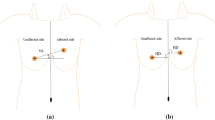Abstract
Background
Proper nipple-areolar complex position in reduction mammoplasty patients is a challenging problem regardless of the preferred technique. Postoperatively, the nipple-areolar complex is often not located at the most projected area of the breast. This retrospective observational study aimed to find the long-term measurements of the nipple-areolar complex position and inferior pole length after inverted T scar-superomedial pedicle reduction mammoplasty.
Methods
Forty-eight female patients (96 breasts) were included in this study. The inclusion criteria were that no previous operation should have been done on any of the breasts and both NAC complexes should be at least 30 cm from the midclavicular point. Preoperatively, the distance from the midclavicular point to the new nipple was recorded. All patients were operated on with the inverted T pattern and superomedial pedicle technique. The resection weights, the distance from the midclavicular point to the nipple distance, and the distance from the NAC lower border to the inframammary fold were evaluated postoperatively with an average of 15-month follow-up.
Results
The mean preoperative distance from the midclavicular point to the nipple was 34.21 cm for the right breast and 34.26 cm for the left breast. The mean resection weight per breast was 1035 g for the right breast and 1081 g for the left breast. The descent of the NAC was 1.61 cm for the right breast and 1.79 cm for left breast (mean: 1.7 cm) at the end of the follow-up. Additionally, the inframammary length increased 3.31 cm for the right breast and 3.59 cm for the left breast (mean: 3.45 cm).
Conclusion
In this study, we found that the new nipple-areolar complex does not go upward but goes downward. However, it was not located at the most projected area of the breast as it was set intra-operatively. This was because the lower pole of the breast sagged more than the nipple: clinically, we observed a nipple superior displacement of 1.75 cm (3.45 − 1.7 = 1.75). According to this calculation, we believe that the new nipple position should be marked at 1.5–1.75 cm below the most projected area of the breast after final shaping so that in the long term, the nipple-areolar complex would be at the proper position.
Level of Evidence V
This journal requires that authors assign a level of evidence to each article. For a full description of these Evidence-Based Medicine ratings, please refer to the Table of Contents or the online Instructions to Authors www.springer.com/00266.






Similar content being viewed by others
References
Ahmad J, Lista F (2008) Vertical scar reduction mammaplasty: the fate of nipple-areola complex position and inferior pole length. Plast Reconstr Surg 121(4):1084–1091
Akyurek M (2011) Contouring the inferior pole of the breast in vertical mammaplasty: suction-assisted lipectomy versus direct defatting. Plast Reconstr Surg 127(3):1314–1322
Amini P et al (2010) Vertical reduction mammaplasty combined with a superomedial pedicle in gigantomastia. Ann Plast Surg 64(3):279–285
Freiberg A, Carr M (1994) Reduction mammaplasty: position of the nipple-areolar complex after long-term follow-up. Can J Plast Surg 2:117
Gulyas G (2004) Marking the position of the nipple-areola complex for mastopexy and breast reduction surgery. Plast Reconstr Surg 113(7):2085–2090
Hall-Findlay EJ (2010) The three breast dimensions: analysis and effecting change. Plast Reconstr Surg 125(6):1632–1642
Hall-Findlay EJ (1999) A simplified vertical reduction mammaplasty: shortening the learning curve. Plast Reconstr Surg 104(3):748–759
Landau AG, Hudson DA (2008) Choosing the superomedial pedicle for reduction mammaplasty in gigantomastia. Plast Reconstr Surg 121(3):735–739
Lassus C (1999) Update on vertical mammaplasty. Plast Reconstr Surg 104(7):2289–2298 discussion 2299–2304
Meshulam-Derazon S et al (2009) Large-volume breast reduction: long-term results. Scand J Plast Reconstr Surg Hand Surg 43(2):65–70
Okoro SA et al (2008) Breast reduction trend among plastic surgeons: a national survey. Plast Reconstr Surg 122(5):1312–1320
Reus WF, Mathes SJ (1988) Preservation of projection after reduction mammaplasty: long-term follow-up of the inferior pedicle technique. Plast Reconstr Surg 82(4):644–652
Small KH, Tepper OM, Unger JG, Kumar N, Feldman DL, Choi M, Karp NS (2010) Re-defining pseudoptosis from a 3D perspective after short scar-medial pedicle reduction mammaplasty. J Plast Reconstr Aesthet Surg (Feb) 63(2):346–353
Spear SL, Howard MA (2003) Evolution of the vertical reduction mammaplasty. Plast Reconstr Surg 112(3):855–868 quiz 869
Zehm S et al (2012) Inferior pole length and long-term aesthetic outcome after superior and inferior pedicled reduction mammaplasty. Aesthet Plast Surg 36(5):1128–1133
Acknowledgments
None of the authors has a financial interest in any of the products, devices, or drugs mentioned in this manuscript
Conflict of interest
There is no conflict of interest between the authors.
Author information
Authors and Affiliations
Corresponding author
Rights and permissions
About this article
Cite this article
Altuntaş, Z.K., Kamburoğlu, H.O., Yavuz, N. et al. Long-Term Changes in Nipple-Areolar Complex Position and Inferior Pole Length in Superomedial Pedicle Inverted ‘T’ Scar Reduction Mammaplasty. Aesth Plast Surg 39, 325–330 (2015). https://doi.org/10.1007/s00266-015-0470-3
Received:
Accepted:
Published:
Issue Date:
DOI: https://doi.org/10.1007/s00266-015-0470-3




